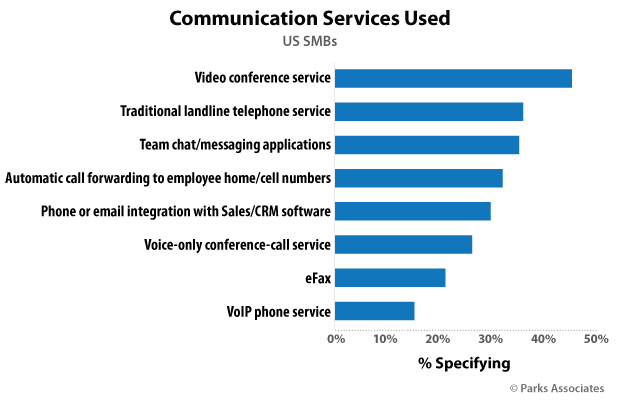The COVID-19 crisis and months of shelter-in-place/lockdown orders have changed operations for all businesses, especially small and medium-sized businesses (SMBs), which have had to adjust to reduced budgets and broad-scale shifts to work from home. The move to a remote workforce means deploying new software, like voice and video conferencing, to keep employees working at home productively.
In fact, video conferencing services are now more common among SMBs than landline telephone services, with 44% adoption for video conferencing compared to only 35% that have landline services. According to Parks Associates’ New SMB Landscape: Devices, Communication, Security, Support, Zoom is now the second most commonly used application out of the 25 software applications tested in the survey among SMBs, behind Excel and ahead of MS Word and Outlook.

In 2020, all video conferencing providers have raced to bolster their offerings and introduce new features. For instance, Microsoft Teams added breakout rooms to allow meeting participants to split into small groups, while Zoom announced end-to-end encryption capabilities. Notably, Verizon entered this market by purchasing BlueJeans for ~$400M in April 2020.
Most SMBs report that, as they adapt to these new circumstances, they face decreased earnings and have reduced hiring, but in accommodating a larger percentage of employees working from home, their spending on voice, video, and IT services increased. Parks Associates research shows that 32% of SMBs report increased spending on voice and video conferencing services. SMBs at risk of going out of business due to COVID-19 report even greater spending than those at no risk of going out of business—a sign that SMBs consider video conferencing solutions critical to adapting their businesses to new market realities.
Also, SMBs that already devote a large number of resources to IT are even more likely to increase spending on voice and video services due to COVID-19, so they will rely even more on their service providers and vendors to help with this ongoing shift in business operations. Parks Associates finds that over the next six months, SMBs generally expect expenses to continue increasing, including spending on voice, video, and IT services.
For ISPs, there is an opportunity to provide cameras, software, and staging and lighting services as a premium video conferencing service. Additionally, ISPs can consider offering bundles to SMB customers featuring business broadband bundled with video conferencing. ISPs have an opportunity to expand their services among current SMB clients that already have a significant technology profile and also extend their footprint by offer support and service option targeting SMBs who have new tech needs.
For a deeper look at the SMB’s changing technology product and service needs, please check out Parks Associates’ new SMB Landscape: Devices, Communication, Security, Support.


